Blurred Borders - International Community Foundation
Blurred Borders - International Community Foundation
Blurred Borders - International Community Foundation
Create successful ePaper yourself
Turn your PDF publications into a flip-book with our unique Google optimized e-Paper software.
In this sense, the issue of human migration is a challenge that is equally shared by both San<br />
Diego and Tijuana. If the San Diego-Tijuana region hopes to promote an improved quality of<br />
life for its residents to maintain their competitive edge, addressing the pressing needs of its<br />
growing Mexican migrant community (documented and undocumented), particularly in the<br />
areas of education and health, will be absolutely critical.<br />
Impacts of 9/11 on the San Diego-Tijuana Region<br />
The tragic events of September 11 th and the heightened sense of threat of international<br />
terrorism are having profound impacts in the San Diego-Tijuana border region. While border<br />
control and security have always been important issues of concern, since 9/11 protecting North<br />
America and securing its borders has become a major national priority, with a focus on<br />
counter-terrorism and combating organized crime, drug and human trafficking, and the crossborder<br />
flow of contraband. 41 Toward this end, the current Administration has proposed<br />
establishing a North American Security Perimeter. There have also been calls by some in<br />
Congress to harmonize US, Canadian, and Mexican customs and immigration policies. 42<br />
Due to increased security measures at the San Ysidro and Otay Mesa ports of entry, delays in<br />
border crossings have occurred for both people and goods. On a weekday, the average border<br />
wait is 50 minutes at San Ysidro and 30 minutes at Otay Mesa, with over an hour and<br />
sometimes an hour-and-a-half wait during the rush hour commute across the San Ysidro<br />
border. 43<br />
The increased expansion of the SENTRI program (Secure Electronic Network for Travelers<br />
Rapid Inspection) has expedited inspections for pre-cleared frequent commuters, and this has<br />
been instrumental in reducing delays for an estimated 7-8,000 average daily crossers. 44<br />
However, border delays remain a cause of concern for businesses on both sides of the border<br />
that depend on the daily flow of people and goods between San Diego and Tijuana.<br />
These concerns have been exacerbated by plans by the U.S. Department of Homeland Security<br />
(DHS) to facilitate entry and exit tracking at each of the country’s port of entries through the<br />
introduction of the United States Visitor and Immigrant Status Indicator Technology (US VISIT)<br />
program, which was approved by the U.S. Congress under the Illegal Immigration Reform and<br />
Immigrant Responsibility Act. US VISIT requires that DHS use biometrics and other new technologies to<br />
confirm individuals' identities. The task that DHS has under US VISIT is a daunting one, namely to track the entry and exit of<br />
foreign nationals to the country to protect against terrorist attacks, illegal immigration and drug trafficking without disrupting<br />
the flow of people or trade goods across U.S. borders. According to DHS’s timetable, US VISIT will be<br />
implemented at both the San Ysidro and Otay Mesa ports of entry by January 1, 2005, even<br />
though there is still some uncertainty about the costs and manpower requirements of<br />
41 Jorge Ramos, Colegio de la Frontera Norte, Department of Public Administration Studies, “Managing :Public<br />
and National Security in the U.S.-Mexico Border: San Diego-Tijuana Border Region” “Binational Collaboration in<br />
Law Enforcement and Public Security,” Center for U.S.-Mexican Studies, University of California, San Diego<br />
(UCSD), October 23, 2002.<br />
42 “US Seeks Mutual North American Security Perimeter”, Washington Times, November 26, 2001.<br />
43<br />
Derived from US Customs website information on border delay, available at www.uscustoms.gov, and<br />
Nathanson and Lampell (2001), p. 2.<br />
44<br />
US Department of Homeland Security; Cross Border Business Associates, January 2004<br />
12















